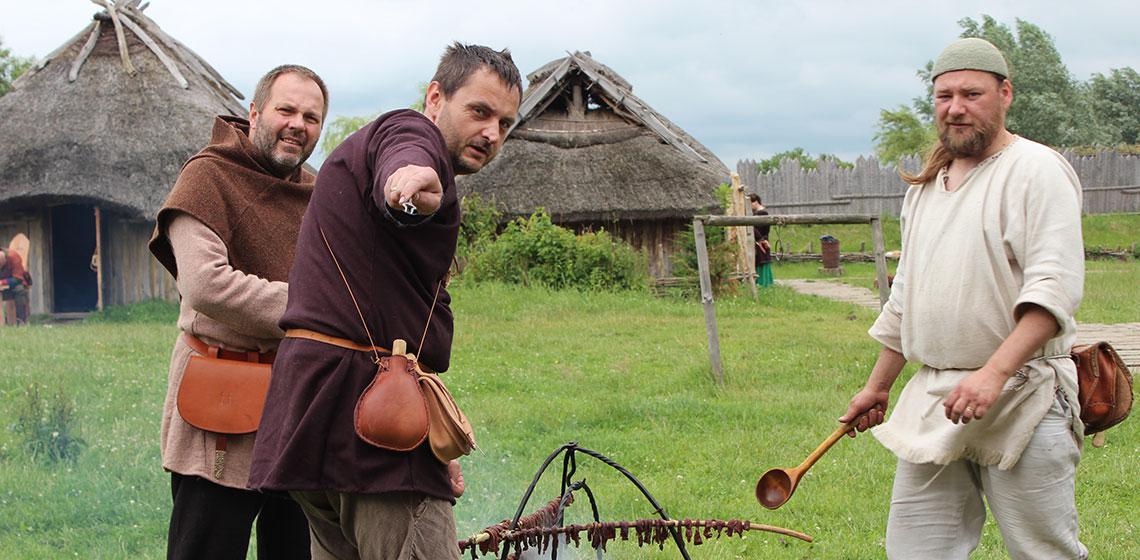Slavs and Vikings’ Center in Wolin (PL)

This time, we will be visiting Wolin, a town located on Poland’s largest island (of the same name) on the coast of the Baltic Sea, in the Land of 44 Islands. Wolin is a City of History, whose glory days date back to 1000 years ago. In the early Middle Ages, it was one of the largest and most powerful cities in this part of Europe, and ranked among the most important ports of the Baltic Sea.
The city lay at the intersection of trade routes and was known as a “merchant republic”. It was mainly inhabited by Slavs, but as it was open to everyone, it attracted people of many cultures and religions from all over the world. Here, the East connected with the West and the North with the South. The visitors and newcomers included merchants from distant countries travelling along the Amber or Silk Road, but also the menacing Vikings.
Anyone who would like to learn about Wolin’s history and listen to the echoes of bygone days is welcome to enter the gates of the Slavs and Vikings’ Center, one of Poland’s most interesting tourist attractions. This recreated settlement offers a glimpse into the everyday life of Wolin’s inhabitants in the period from the 9th to the 12th century. Its buildings have been painstakingly recreated on the basis of archaeological research from the area of Wolin. It currently features a defensive gate with a palisade, craftsmen's shelters, a wooden wharf for boat replicas and 27 reconstructions of early medieval houses. These cottages are created in five different styles, their structure heavily inspired by the abundance of wood in the local forests and historical events, such as raids and the burning of the city.
The center presents the Slavic and Scandinavian cultures, which had the most impact on the development of the city. Make no mistake, this is not a traditional museum. There are no historical items on display here, only reconstructions and stylizations of cottages, along with their furnishings. This lets you freely roam around the area, go everywhere, touch everything, sit on a bench at a table, lie down on a bed, try on costumes or armor, train archery or taste the products of old cuisine. Photos taken in such scenery are truly unique and make for wonderful souvenirs.
The village hosts old-craft workshops, history-themed events, outdoor games for children, as well as networking parties and events for companies or participants of conferences organized locally. During the experimental archeology workshops conducted here, you can learn the crafts of old, gain an interesting experience or take up a new hobby. The instructors are historical reenactors with many years of practice. Experimental archeology is not only about reconstructing the objects – it also involves discovering and learning the arcana of how to make them using the original methods and tools. The cottages in the settlement are seasonally inhabited by historical reenactors, often with their families. Dressed as was the custom, they use their stoves to cook inside their homes and spend their time sewing costumes and going about various daily business. The entire settlement looks as if it was literally transported from distant times, which lends it that special atmosphere so cherished by tourists who often cannot help but assist the villagers in their chores in an urge to experience time travel, if only for a few moments.
The open-air museum also hosts a plethora of historical events, including one of the largest early-medieval events in the world – the Slavs and Vikings Festival, which will be held for the 25th time on 2-4 August 2019. The festival is attended by over 2,000 participants - historical reenactors from over 30 countries around the world. Dressed in meticulously recreated costumes, they present the early Middle Ages and the multiculturalism of Wolin from centuries ago. In addition to the Slavs and Vikings, to whom the Festival owes its name, you can also meet Balts, Waregs, Ruthenians, but also Magyars, with their yurts and... a Byzantine princess. There are battles waged by 600-strong armies of warriors, splendid regatta and cruises of recreated Viking and Slavonic boats, demonstrations of early music groups, reconstructions of historical events, and, last but not least, contests and games for Middle Ages buffs, both big and small. Every year, the festival is visited by over 30,000 tourists from many corners of the world.
The Slavs and Vikings’ Center is open from April to October and you can visit it both individually and in guided groups. Our guides will present the local history and buildings in a unique way. It is an interesting option for spending your free time when you are in West Pomerania or on a holiday at the seaside. Within the ten years of its activity, the village has become a recognized place, attracting enthusiasts of history from 1000 years ago, as well as those who yearn to catch their breath away from the hustle and bustle of the modern world and need a moment of peace and quiet to unwind.
Welcome.
